Yanjie Ze
TWIST: Teleoperated Whole-Body Imitation System
May 05, 2025Abstract:Teleoperating humanoid robots in a whole-body manner marks a fundamental step toward developing general-purpose robotic intelligence, with human motion providing an ideal interface for controlling all degrees of freedom. Yet, most current humanoid teleoperation systems fall short of enabling coordinated whole-body behavior, typically limiting themselves to isolated locomotion or manipulation tasks. We present the Teleoperated Whole-Body Imitation System (TWIST), a system for humanoid teleoperation through whole-body motion imitation. We first generate reference motion clips by retargeting human motion capture data to the humanoid robot. We then develop a robust, adaptive, and responsive whole-body controller using a combination of reinforcement learning and behavior cloning (RL+BC). Through systematic analysis, we demonstrate how incorporating privileged future motion frames and real-world motion capture (MoCap) data improves tracking accuracy. TWIST enables real-world humanoid robots to achieve unprecedented, versatile, and coordinated whole-body motor skills--spanning whole-body manipulation, legged manipulation, locomotion, and expressive movement--using a single unified neural network controller. Our project website: https://humanoid-teleop.github.io
X-Capture: An Open-Source Portable Device for Multi-Sensory Learning
Apr 03, 2025Abstract:Understanding objects through multiple sensory modalities is fundamental to human perception, enabling cross-sensory integration and richer comprehension. For AI and robotic systems to replicate this ability, access to diverse, high-quality multi-sensory data is critical. Existing datasets are often limited by their focus on controlled environments, simulated objects, or restricted modality pairings. We introduce X-Capture, an open-source, portable, and cost-effective device for real-world multi-sensory data collection, capable of capturing correlated RGBD images, tactile readings, and impact audio. With a build cost under $1,000, X-Capture democratizes the creation of multi-sensory datasets, requiring only consumer-grade tools for assembly. Using X-Capture, we curate a sample dataset of 3,000 total points on 500 everyday objects from diverse, real-world environments, offering both richness and variety. Our experiments demonstrate the value of both the quantity and the sensory breadth of our data for both pretraining and fine-tuning multi-modal representations for object-centric tasks such as cross-sensory retrieval and reconstruction. X-Capture lays the groundwork for advancing human-like sensory representations in AI, emphasizing scalability, accessibility, and real-world applicability.
BEHAVIOR Robot Suite: Streamlining Real-World Whole-Body Manipulation for Everyday Household Activities
Mar 07, 2025Abstract:Real-world household tasks present significant challenges for mobile manipulation robots. An analysis of existing robotics benchmarks reveals that successful task performance hinges on three key whole-body control capabilities: bimanual coordination, stable and precise navigation, and extensive end-effector reachability. Achieving these capabilities requires careful hardware design, but the resulting system complexity further complicates visuomotor policy learning. To address these challenges, we introduce the BEHAVIOR Robot Suite (BRS), a comprehensive framework for whole-body manipulation in diverse household tasks. Built on a bimanual, wheeled robot with a 4-DoF torso, BRS integrates a cost-effective whole-body teleoperation interface for data collection and a novel algorithm for learning whole-body visuomotor policies. We evaluate BRS on five challenging household tasks that not only emphasize the three core capabilities but also introduce additional complexities, such as long-range navigation, interaction with articulated and deformable objects, and manipulation in confined spaces. We believe that BRS's integrated robotic embodiment, data collection interface, and learning framework mark a significant step toward enabling real-world whole-body manipulation for everyday household tasks. BRS is open-sourced at https://behavior-robot-suite.github.io/
Learning Smooth Humanoid Locomotion through Lipschitz-Constrained Policies
Oct 15, 2024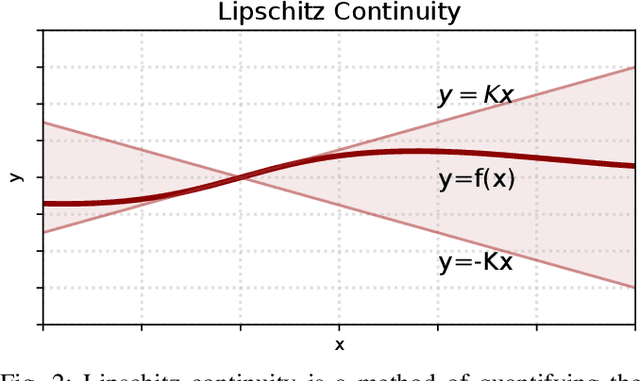
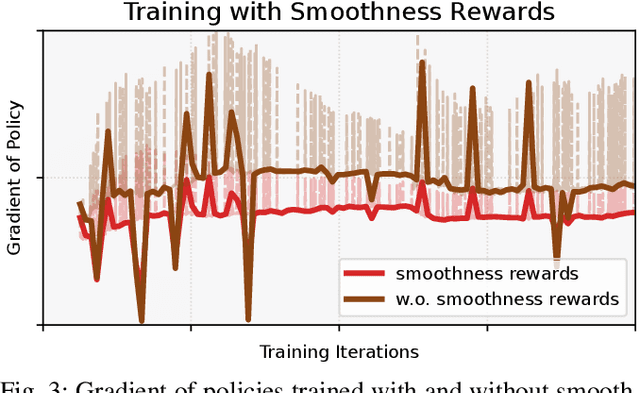

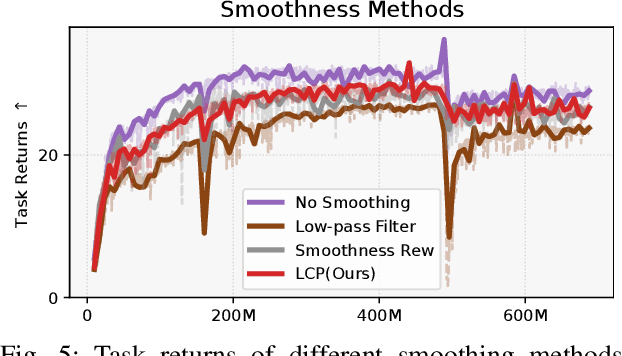
Abstract:Reinforcement learning combined with sim-to-real transfer offers a general framework for developing locomotion controllers for legged robots. To facilitate successful deployment in the real world, smoothing techniques, such as low-pass filters and smoothness rewards, are often employed to develop policies with smooth behaviors. However, because these techniques are non-differentiable and usually require tedious tuning of a large set of hyperparameters, they tend to require extensive manual tuning for each robotic platform. To address this challenge and establish a general technique for enforcing smooth behaviors, we propose a simple and effective method that imposes a Lipschitz constraint on a learned policy, which we refer to as Lipschitz-Constrained Policies (LCP). We show that the Lipschitz constraint can be implemented in the form of a gradient penalty, which provides a differentiable objective that can be easily incorporated with automatic differentiation frameworks. We demonstrate that LCP effectively replaces the need for smoothing rewards or low-pass filters and can be easily integrated into training frameworks for many distinct humanoid robots. We extensively evaluate LCP in both simulation and real-world humanoid robots, producing smooth and robust locomotion controllers. All simulation and deployment code, along with complete checkpoints, is available on our project page: https://lipschitz-constrained-policy.github.io.
Generalizable Humanoid Manipulation with Improved 3D Diffusion Policies
Oct 14, 2024



Abstract:Humanoid robots capable of autonomous operation in diverse environments have long been a goal for roboticists. However, autonomous manipulation by humanoid robots has largely been restricted to one specific scene, primarily due to the difficulty of acquiring generalizable skills. Recent advances in 3D visuomotor policies, such as the 3D Diffusion Policy (DP3), have shown promise in extending these capabilities to wilder environments. However, 3D visuomotor policies often rely on camera calibration and point-cloud segmentation, which present challenges for deployment on mobile robots like humanoids. In this work, we introduce the Improved 3D Diffusion Policy (iDP3), a novel 3D visuomotor policy that eliminates these constraints by leveraging egocentric 3D visual representations. We demonstrate that iDP3 enables a full-sized humanoid robot to autonomously perform skills in diverse real-world scenarios, using only data collected in the lab. Videos are available at: https://humanoid-manipulation.github.io
Catch It! Learning to Catch in Flight with Mobile Dexterous Hands
Sep 16, 2024Abstract:Catching objects in flight (i.e., thrown objects) is a common daily skill for humans, yet it presents a significant challenge for robots. This task requires a robot with agile and accurate motion, a large spatial workspace, and the ability to interact with diverse objects. In this paper, we build a mobile manipulator composed of a mobile base, a 6-DoF arm, and a 12-DoF dexterous hand to tackle such a challenging task. We propose a two-stage reinforcement learning framework to efficiently train a whole-body-control catching policy for this high-DoF system in simulation. The objects' throwing configurations, shapes, and sizes are randomized during training to enhance policy adaptivity to various trajectories and object characteristics in flight. The results show that our trained policy catches diverse objects with randomly thrown trajectories, at a high success rate of about 80\% in simulation, with a significant improvement over the baselines. The policy trained in simulation can be directly deployed in the real world with onboard sensing and computation, which achieves catching sandbags in various shapes, randomly thrown by humans. Our project page is available at https://mobile-dex-catch.github.io/.
Learning Visual Quadrupedal Loco-Manipulation from Demonstrations
Mar 29, 2024Abstract:Quadruped robots are progressively being integrated into human environments. Despite the growing locomotion capabilities of quadrupedal robots, their interaction with objects in realistic scenes is still limited. While additional robotic arms on quadrupedal robots enable manipulating objects, they are sometimes redundant given that a quadruped robot is essentially a mobile unit equipped with four limbs, each possessing 3 degrees of freedom (DoFs). Hence, we aim to empower a quadruped robot to execute real-world manipulation tasks using only its legs. We decompose the loco-manipulation process into a low-level reinforcement learning (RL)-based controller and a high-level Behavior Cloning (BC)-based planner. By parameterizing the manipulation trajectory, we synchronize the efforts of the upper and lower layers, thereby leveraging the advantages of both RL and BC. Our approach is validated through simulations and real-world experiments, demonstrating the robot's ability to perform tasks that demand mobility and high precision, such as lifting a basket from the ground while moving, closing a dishwasher, pressing a button, and pushing a door. Project website: https://zhengmaohe.github.io/leg-manip
3D Diffusion Policy
Mar 06, 2024Abstract:Imitation learning provides an efficient way to teach robots dexterous skills; however, learning complex skills robustly and generalizablely usually consumes large amounts of human demonstrations. To tackle this challenging problem, we present 3D Diffusion Policy (DP3), a novel visual imitation learning approach that incorporates the power of 3D visual representations into diffusion policies, a class of conditional action generative models. The core design of DP3 is the utilization of a compact 3D visual representation, extracted from sparse point clouds with an efficient point encoder. In our experiments involving 72 simulation tasks, DP3 successfully handles most tasks with just 10 demonstrations and surpasses baselines with a 55.3% relative improvement. In 4 real robot tasks, DP3 demonstrates precise control with a high success rate of 85%, given only 40 demonstrations of each task, and shows excellent generalization abilities in diverse aspects, including space, viewpoint, appearance, and instance. Interestingly, in real robot experiments, DP3 rarely violates safety requirements, in contrast to baseline methods which frequently do, necessitating human intervention. Our extensive evaluation highlights the critical importance of 3D representations in real-world robot learning. Videos, code, and data are available on https://3d-diffusion-policy.github.io .
Generalizable Visual Reinforcement Learning with Segment Anything Model
Dec 28, 2023Abstract:Learning policies that can generalize to unseen environments is a fundamental challenge in visual reinforcement learning (RL). While most current methods focus on acquiring robust visual representations through auxiliary supervision, pre-training, or data augmentation, the potential of modern vision foundation models remains underleveraged. In this work, we introduce Segment Anything Model for Generalizable visual RL (SAM-G), a novel framework that leverages the promptable segmentation ability of Segment Anything Model (SAM) to enhance the generalization capabilities of visual RL agents. We utilize image features from DINOv2 and SAM to find correspondence as point prompts to SAM, and then SAM produces high-quality masked images for agents directly. Evaluated across 8 DMControl tasks and 3 Adroit tasks, SAM-G significantly improves the visual generalization ability without altering the RL agents' architecture but merely their observations. Notably, SAM-G achieves 44% and 29% relative improvements on the challenging video hard setting on DMControl and Adroit respectively, compared to state-of-the-art methods. Video and code: https://yanjieze.com/SAM-G/
Diffusion Reward: Learning Rewards via Conditional Video Diffusion
Dec 21, 2023
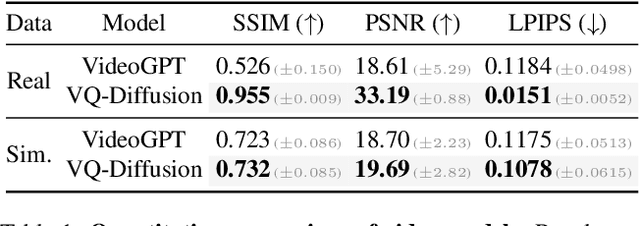
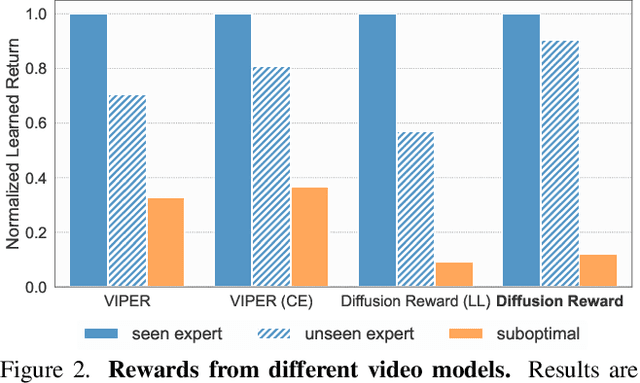
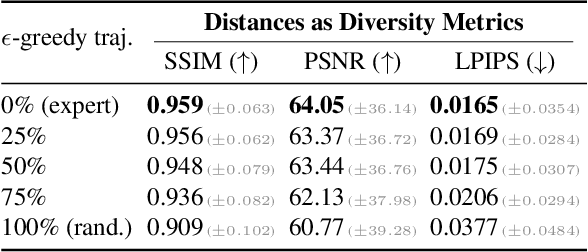
Abstract:Learning rewards from expert videos offers an affordable and effective solution to specify the intended behaviors for reinforcement learning tasks. In this work, we propose Diffusion Reward, a novel framework that learns rewards from expert videos via conditional video diffusion models for solving complex visual RL problems. Our key insight is that lower generative diversity is observed when conditioned on expert trajectories. Diffusion Reward is accordingly formalized by the negative of conditional entropy that encourages productive exploration of expert-like behaviors. We show the efficacy of our method over 10 robotic manipulation tasks from MetaWorld and Adroit with visual input and sparse reward. Moreover, Diffusion Reward could even solve unseen tasks successfully and effectively, largely surpassing baseline methods. Project page and code: https://diffusion-reward.github.io/.
 Add to Chrome
Add to Chrome Add to Firefox
Add to Firefox Add to Edge
Add to Edge